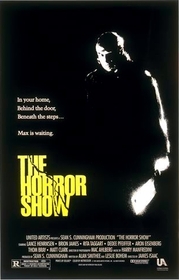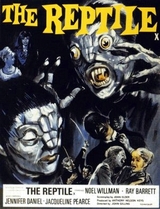Our editor-in-chief Nate Yapp is proud to have contributed to the new book Hidden Horror: A Celebration of 101 Underrated and Overlooked Fright Flicks, edited by Aaron Christensen. Another contributors include Anthony Timpone, B.J. Colangelo, Dave Alexander, Classic-Horror.com's own Robert C. Ring and John W. Bowen. Pick up a copy today from Amazon.com!
The Horror Show (1989)
At turns scary, suspenseful, surreal and saucy, James Isaac's directorial debut, Horror Show, a film produced by Sean Cunningham of Friday the 13th fame, is both satisfying and sadly underrated.
I have to admit that when I first shut off the lights and started the film I had a scare of a less entertaining sort. As soon as I saw, "written by Alan Smithee . . ." I thought I was in for a long, groan-inducing 90-plus minutes. As many of you know, Smithee is a pseudonym that directors, writers, etc. use when they've worked on a film that they're later embarrassed or otherwise disenchanted with and want to disown. My fear was unwarranted, however, and after a bit of research I still haven't been able to figure out why one of the scripters wanted to be dissociated with the film or why initial director David Blyth left the production. There sure didn't seem to be any serious flaws with The Horror Show's script or direction (supposedly some of Blyth's work remains intact) in my opinion. Maybe the deserters just didn't dig horror flicks and thought they were going to be involved with a Mr. Smith Goes to Washington kind of film with a more colorful title.
Two of my favorite genre-oriented actors, Lance Henriksen and late Brion James, are the focal points. Henriksen is Detective Lucas McCarthy, a psychologically tormented detective on a leave of absence, and James is Max Jenke, the sociopathic serial killer who catalyzed McCarthy's distress. Jenke's weapon of choice is a meat cleaver, and his game of choice is playing cat and mouse with McCarthy. We learn some of this through expertly realized backstory, as Jenke is actually about to go to the electric chair as The Horror Show begins. After some gripping exposition, we see Jenke strapped to the chair. They turn the juice on. It takes 10 minutes to kill him. But is he really dead, or will his desire to torment McCarthy keep him alive somehow, if only in McCarthy's mind?
It's a great set-up, and allows Isaac and the scripters to craft a story that dwells between supernatural horror and McCarthy's apparent insanity. Although the ending would be a bit questionable in this view, it is possible to read almost all of the events as occurring only in McCarthy's mind. A more literal reading gives us something like Pulse meets Shocker meet A Nightmare on Elm Street -- although that's not meant as a knock, necessarily; The Horror Show actually predates Shocker (although it's not always possible to say which, if any, script might have influenced the other in preproduction stages).
The Pulse and Elm Street similarities are mostly superficial, and never feel like a direct rip. The Elm Street influences being more prominent, especially in The Horror Show's Wes Craven-ish dream/reality melding/shaping (for example, during the intro, or the pregnancy scene) and the function of the furnace.
While the Craven influence isn't a flaw, a John Carpenter-ish pseudoscience angle, ala Prince of Darkness (and ironically, an important figure in the pseudoscience scenes, Thom Bray, was also in Prince of Darkness), is a flaw. Scripters Leslie Bohem and Allyn Warner introduce an unnecessary, convoluted, sci-fi electromagnetism explanation for Jenke's ability to overcome the electric chair. It sounds silly, the way it's realized in the film is a bit daft, and since there's either something supernatural going on or McCarthy is nuts or both, it undermines the effectiveness of those factors.
Otherwise, the performances are superb, the cinematography, editing, set design (there's even a disturbing kitchen that may have influenced Seven), etc. are all excellent, and most importantly, Isaacs creates a scary, serious (alright, except for the goofy turkey effect), disturbing dream-atmosphere that prevails throughout the film. The Horror Show isn't completely without camp, but the camp always fits. He manages to do this under duress -- defecting writers and having to take over the film after principle photography began -- and with a scant budget. Equally remarkable given the budget is the effects work by the always amazing KNB. Yes, some of the effects seem a bit cheap -- we all know that that cop's head isn't really severed and sitting on a plate, but poking up from beneath the table -- but the effects work, and that's what is important. They're creepy and gory and satisfying.
Unfortunately, as I did a bit of research after watching the film, I discovered that as good as the effects are, what was created for the film and shot was even better and gorier. In Fangoria's cover feature on the film (issue # 81, April 1989) a telling Table of Contents tag reads, "If Horror Show survives its trip to the MPAA, expect to see the goriest flick in ages." Based on the accompanying photographs with the feature, Horror Show didn't survive its trip to the MPAA very well. Graphic effects such as bodies severed at the trunk; sexy, bloody legs protruding from the top of a meatgrinder; McCarthy's son's mangled ear; and McCarthy's beating heart showing through his wound were all either absent from the film or only shown for a split second. Oddly, the feature itself doesn't mention anything about possible censorship problems, but obviously The Horror Show encountered some. Still, the film doesn't really suffer for a lack of gore, but extra sauce might have upped the score a point and made up for the wacky science.
Also, I'm still a bit intrigued as to how The Horror Show came to be known as House III. My guess is that, since Cunningham was also responsible for the House films, after initial sales of The Horror Show video slowed down, the distributors and/or Cunningham himself decided to slap a "House III" moniker on this flick to try to increase sales by association. Surely, The Horror Show in its original release in the theaters and video cassette (I have an original VHS copy) make no mention of a House connection, and neither does the Fango article. I think it is misguided to consider this a House sequel.
If you forget that marketing quirk, and try not to get too upset at the evil entity that is the MPAA, The Horror Show is a more than enjoyable flick for fans of the genre. Despite its gore (there's still plenty in the film), the scares, atmosphere and above average story make this film worth watching for just about everyone, even grandma.








